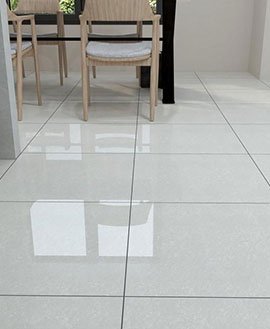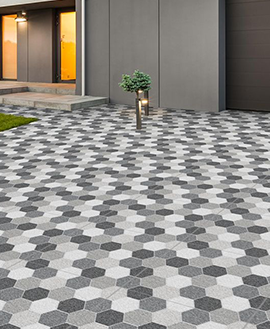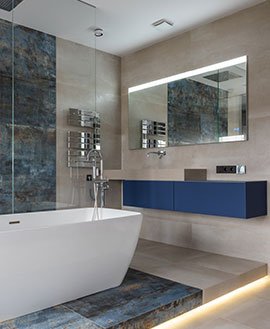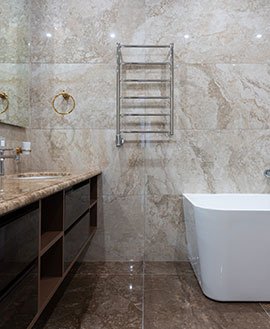Selecting natural stone or porcelain for your project can be difficult. Although natural stone has always been preferred for its timeless beauty, homeowners in Cincinnati and Columbus, Ohio are starting to use porcelain more frequently.
To assist you in choosing the ideal option for your project, we’ll go over the main distinctions between porcelain tiles and natural stones in this blog post. In order to help you select the best choice for your house, we will walk you through the advantages and disadvantages of natural stone and porcelain.
Based on your unique requirements and design preferences, you may make an informed decision by comparing the attributes of each material.
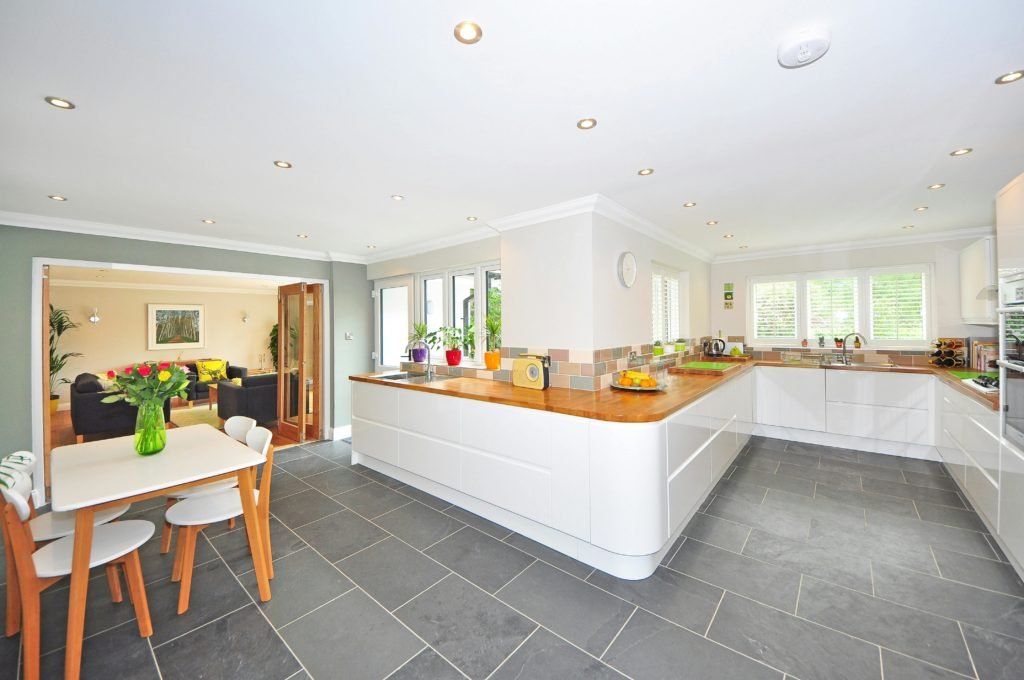
PRICE
Cost is a significant consideration when comparing porcelain with natural stone. Porcelain tiles are more reasonably priced; their average cost per square foot is between $3 and $10. However, depending on the type of stone selected, real stone tiles might cost anywhere from $5 and $20 per square foot. Making the right choice between porcelain and natural stone for your project might be aided by being aware of the price variations.
INSTALLATION PROCEDURE
Especially for do-it-yourself projects, porcelain tiles require less effort to install than actual stone. Because porcelain tiles are consistent in size and form, cutting and fitting them together along uniform grout lines is made easy. However, because natural stone tiles come in a variety of sizes and shapes and can be more difficult to cut and install, they require more attention to detail and experience during installation. Porcelain tiles can be the finest alternative for your project if you’re searching for an affordable and simple installation solution.
VALUE
Both natural stone and porcelain tiles can undoubtedly raise the value of your house, but natural stone usually yields a larger return on investment. Installing natural stone tiles can return up to 90% of the installation cost, while installing porcelain tile can return up to 70% of the installation cost, according to the National Association of Home Builders. This is because real stone has a perceived luxury and upscale appearance that can draw in buyers and raise the value of your home.
But in the end, a number of variables, including the caliber of the installation and the general layout of the room, determine the return on investment.
LONG LASTING
Since porcelain is a solid, hard material that is extremely resistant to stains, scratches, and water damage, it is typically thought to be more durable than stone tile. The incredibly severe circumstances that porcelain can sustain are highly appealing to many homes.
Natural stones, on the other hand, may be more prone to chipping and breaking, particularly if the stones are not adequately sealed.
However, the amount of foot traffic and the maintenance schedule can have an effect on how long-lasting any sort of tile is, so you should consider where these stones will be placed.
MOISTURE RESISTANCE
Because of its non-porous surface that prevents water absorption, porcelain tiles are extremely moisture-resistant, making them a great option for damp spaces like kitchens, bathrooms, and laundry rooms.
In contrast, stone tile has a higher porosity, which allows it to gradually absorb water and moisture. If the moisture isn’t sufficiently managed, this might result in discoloration and possibly structural damage.
STAIN RESISTANCE
Because porcelain is a less porous material than natural stone, it is typically more stain-resistant. Porcelain tile is a great option for high-traffic areas like kitchens and bathrooms since it is simple to clean with a damp cloth or mild cleanser.
Natural stone tiles, on the other hand, are more porous and may be more prone to discoloration and stains, particularly if the stones are not adequately sealed. Keep in mind that regular sealing will be necessary to maintain the best-looking natural stone tiles.
LOOKS
The aesthetics of porcelain versus real stone tiles varies, with each having a certain charm of its own.
While porcelain tile can mimic genuine stone, its mass production gives it a more homogeneous appearance.
Conversely, natural flagstone tiles are prized for their inherent variances in hue, design, and texture, which give each tile a unique character. While porcelain tile offers a sleek and contemporary appearance, the natural beauty of stone can add character and warmth to any environment.
UPKEEP
Porcelain tile is typically thought to require less upkeep than natural stone tile, which needs more care to maintain both its durability and attractiveness. With frequent sweeping and mopping, porcelain tile is simple to maintain and clean.
On the other hand, in order to stop etching, staining, and cracking, natural stone tile needs to be periodically sealed and polished. Furthermore, different natural stone varieties demand varying amounts of upkeep, so before making your choice, it’s critical to learn about and comprehend the particular requirements of each form of stone.
The Conclusion
While natural stone and porcelain are both beautiful and long-lasting, porcelain requires less upkeep and is more consistent. When deciding between porcelain and natural stone for your upcoming project, take budget, upkeep, and appearance into account.


